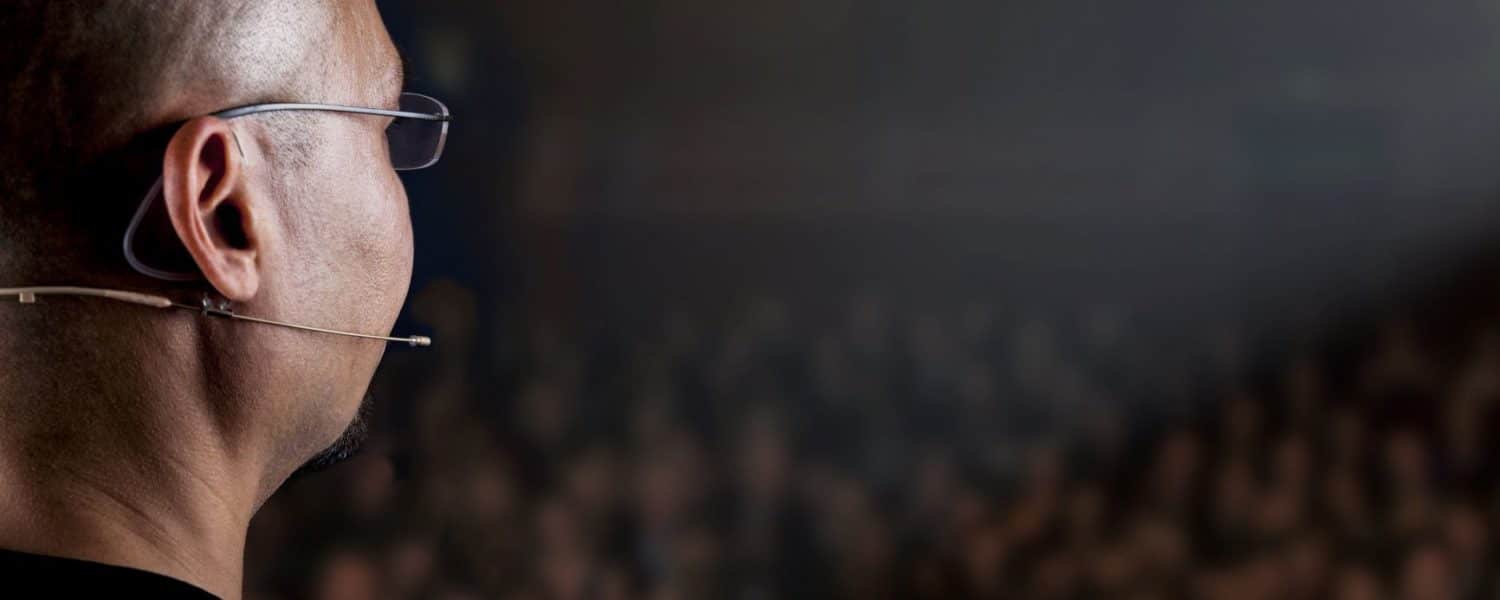Auditoriums, churches, educational facilities, conference rooms, courtrooms and theaters are all places where one or more people speak to an audience.
If that speaker is untrained, and/or doesn’t know to speak up in a clear and articulate manner, this can be an issue. Moreover, the speaker may not use a handheld microphone. Or, he may employ a lavalier microphone, which can cause severe level changes when the speaker turns his head while talking.
The best way to address this challenge is to use a head-worn microphone.
Head-Worn Mics for Singers
When a singer performs on stage with a microphone, he typically has to contend with sounds radiating from musical instruments, monitor speakers and other sources. To avoid this and still ensure the singer’s voice sounds great, use a head-worn directional mic.
Compared to an omnidirectional mic, the cardioid design of a directional mic will pick up only half the amount of the background sound. Furthermore, the low-frequency sounds from loudspeakers, drums, etc., will be reduced to a tenth or less.
Benefits of Wireless Systems
When employed with a wireless system, a head-worn microphone offers a number of advantages. As the microphone is close to the sound source, it does not need to be gained as much, which is beneficial when using several microphones simultaneously.
In addition, it offers speakers the advantage of having total freedom of movement, including in front of screens or boards.
Microphone Technologies: Omnidirectional or Directional?
While few people select omnidirectional handheld microphones for the stage, these mics are much more popular for headsets in conferences, theatres and houses of worship. Most likely, this is due to the security of always having a defined and unwavering mic close to the mouth.
In order to realize the best use of their microphones, live engineers should be familiar with the proximity effect, wind sensitivity and rejection individualities of the different types of directional microphones.
In particular, they should pay attention to the course of a directional headset’s rejection, examining the microphone’s most sensitive path and whether the rejection actually points toward the sources they want to attenuate.
For controlled environments, such as a stage set for a musical, the omnidirectional headset is preferred due to its more natural tone, lack of proximity effect and more forgiving need of placement accuracy. More than 30 channels live is not unusual for microphones used in these scenarios.
Live Engineering
The gain-to-feedback ratio is the most sought-after parameter in live engineering. If the ratio between the sound level of the voice and all other sound levels around it were consistently at the right level, there wouldn’t be a problem. But, in reality, the voice is not able to compete with stage monitors or such instruments as drums and guitars.
This is where the choice of using stage monitors or in-ear monitoring comes into consideration. While the in-ear system is preferable from a gain-to-feedback ratio perspective, the interaction between both a microphone and a PA speaker’s off-axis linearity is what decides the matter. The more perfectly linear both are, the better the sound quality and the gain-to-feedback ratio.
Proximity Effect: How Close Can You Go?
With directional (pressure-gradient) headset microphones, the talent performs within a short distance of the microphone, influencing the bass level. A good headset will feature a proximity effect tailored to its exact application, working within a reasonable distance tolerance.
Omnidirectional Headsets
Omni headsets are sensitive to sound from all directions. The timbre of the sound remains constant regardless of the distance between the sound source and the microphone. The positioning of microphones with omni-directional characteristics is less critical; consequently, they can also be better hidden.
If the user is not accustomed to positioning a microphone, an omni-directional microphone is the obvious choice, as it is generally not very sensitive to wind, breathing and handling noises.
Directional Headsets
Rejection occurs to the sides and rear of cardioid- or supercardioid-patterned directional headsets. This is why it’s best to point them at the mouth, as the sensitivity to sounds coming from the rear is very low at this angle.
All cardioid mics boost low-frequency sound whenever the microphone is close to the sound source, a phenomenon called the proximity effect.
Designing microphones with amazing sound, exceptional consistency and outstanding durability is no easy feat. DPA Microphones draws on more than six decades of world-class microphone design experience, www.dpamicrophones.com.















